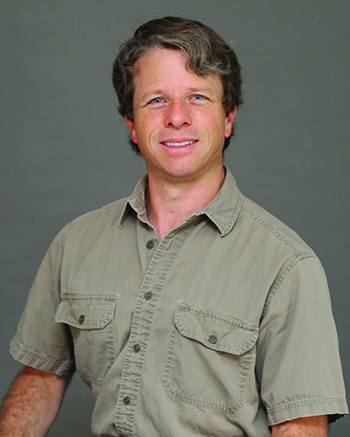Meet the Faculty: Dan Mittleman
Frequencies in the terahertz range could greatly increase the capacity of wireless communications systems. Daniel Mittleman is working to solve technical challenges that would make terahertz improvements possible.
Daniel Mittleman’s main research area can be found somewhere between the infrared and the microwave frequencies on the electromagnetic spectrum.It is a swath of frequencies known as the terahertz range — an emerging research area.
 Compared to its neighbors on the spectrum, the terahertz range has not gotten nearly as much research attention. That is part of why Mittleman, who joins Brown’s School of Engineering as a professor after 19 years at Rice University, is so interested in it.
Compared to its neighbors on the spectrum, the terahertz range has not gotten nearly as much research attention. That is part of why Mittleman, who joins Brown’s School of Engineering as a professor after 19 years at Rice University, is so interested in it.
“Because this range of the spectrum is less well-explored, there are lots of questions and unknowns,” he said. So from the standpoint of someone with a Ph.D.in physics, Mittleman says he is interested in studying the basic science behind terahertz radiation simply “because it’s there.”
But when he puts on his engineering hat, Mittleman says there are plenty of practical reasons to be interested in terahertz radiation. In his lab at Brown, he will focus on two areas where he thinks terahertz waves could have a big impact: wireless communications and spectroscopy.
At present, cellular networks rely solely on microwaves. The system works pretty well for phone calls, but the demands of data transfer are quickly becoming more than microwaves can handle.
Take streaming high-definition video for example.
“In a completely ideal situation, the maximum throughput of the existing cellular architecture is about a factor of 50 below what is necessary to stream the largest format uncompressed HD video,” Mittleman said. “It is not enough to handle existing technologies, let alone technologies that will exist ten years from now. What that says is we are going to need more capacity in our network.”
In a completely ideal situation, the maximum throughput of the existing cellular architecture is about a factor of 50 below what is necessary to stream the largest format uncompressed HD video. It is not enough to handle existing technologies, let alone technologies that will exist ten years from now. What that says is we are going to need more capacity in our network.
Mittleman thinks that capacity can be found by jumping frequencies up to the terahertz range. However, there are lots of technical challenges that must be overcome to make such a network operate.
“The things that I am thinking about are on the component level,” Mittleman said. “For example, you need to be able to modulate the signal — turn it on and off to make a stream of zeros and ones. We do not have anything now that can do that, so that is one thing I will be working on.”
There is also a problem of directing the terahertz signal from a phone toward a tower. Today’s cell phones today send out a microwave signals in all directions, so the signal has little problem finding its mark. But because the terahertz frequency is 100 times higher, the diffraction of the radiation is 100 times less, which means it comes out essentially as a beam, not a broadcast.
“That can be good because you won’t have interference with other people operating at the same frequency, but you don’t want to have to try to aim your phone at the tower,” Mittleman said. “So we’ll need an antenna that can actively steer the beam toward a tower electronically. That’s another area I am interested in looking into.”
The challenges facing terahertz wireless are many and varied, and the solutions will need to be so as well. Mittleman has already started talking to his new Brown colleagues in search of collaborators. He hopes to pull together a team of researchers that can make Brown a hub of terahertz technology research.
And while terahertz wireless networks may be down the road a bit, terahertz spectroscopy is much closer to full fruition. It is an area where Mittleman has already made substantial progress during his time at Rice.
Scientists use spectrometers to probe the properties of matter by watching how it interacts with electromagnetic radiation. There has been increasing interest over the last decade in spectrometers that make use of terahertz waves.
“Materials have a lot of interesting excitations that are living in this range of the spectrum,” he said. “So being able to access those requires a light source in that range.”
Terahertz waves are particularly well-suited for looking at the properties of superconductors and topological insulators (materials that are insulators on the inside, but conduct electricity on their outer shells). By combining terahertz waves with magnetic fields — something Mittleman’s lab will be equipped to do — he can explore the properties of these materials in a way that other techniques cannot.
“Many of the fundamental excitations in these materials fall squarely in the terahertz range,” he said. “If you really want to understand how these things work, you have to look in that area of the spectrum.”
Spectroscopy is another area where collaboration is key. Mittleman says he looks forward to working with colleagues in engineering, physics, and other departments about how to best make use of this emerging technology.